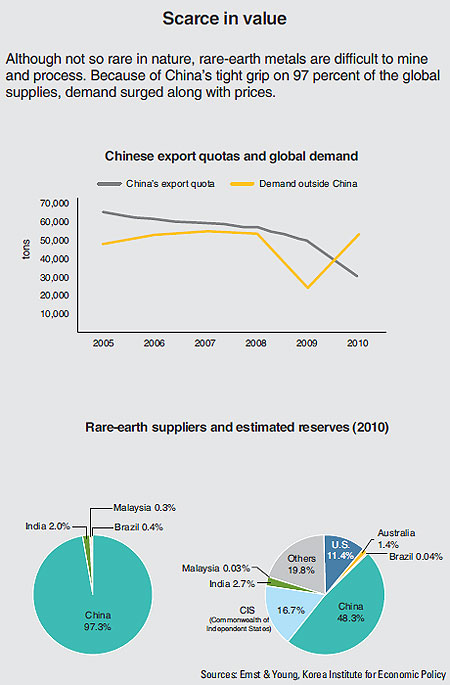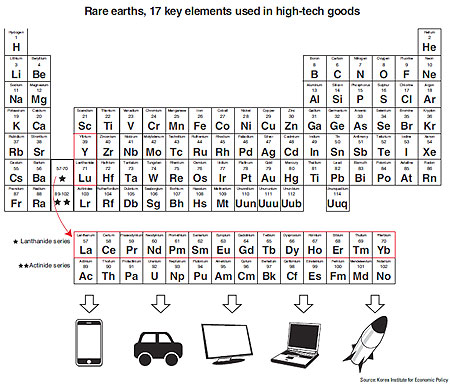Global race for ‘rare earths’
Korea’s effort to find new sources making little headway
Global tension over rare earth metals — often identified as rare earths — has intensified as the United States, European Union and Japan recently teamed up and took it up a notch in pressuring China over persistent trade disputes.
Last month, the trading power players filed a complaint at the World Trade Organization challenging the world’s largest rare earths supplier to remove its export restrictions on the scarce elements used in high-tech goods.
As China continues to tighten its export policy, Korea, a resource-poor country with strong demand for rare earth metals for its high-tech manufacturing, is attempting to stay the course with its biggest trading partner while at the same time, catching up with other nations in the search for alternative reserves.
Late starter
Although not so rare in nature, the 17 elements are critical ingredients for advanced products ranging from flat screen TVs and mobile phones to hybrid car batteries and magnets for sophisticated missiles.
In fact, total production of rare earths is just about 124,000 tons worldwide, making it a few billion dollars market, compared with 1.5 billion tons of iron ore, the main ingredient for steel.
But because they come in compounds rather than as free metals, it takes skill and money to mine, mill and process the rare earths to gain high-purity elements.
China, a supplier of 97 percent of global rare earths, has systematically curbed its export quotas, which jacked up prices, since 2005.
For example, in 2011 the price of Europium oxide, the main component of liquid crystal display screens and fluorescent lighting, shot up 180 percent; dysprosium oxide, included in nuclear reactors, hybrid cars, lasers and sonar systems, jumped by 137 percent; and neodymium oxide, used in cell phones, hard drives and wind turbines grew by 74 percent, according to a report by Deloitte.
Korea has been slow in securing the resources, since it’s been importing semi-processed materials rather than raw supplies. Currently, 80 percent of the imports come from China, and the rest from France and Japan.
However, as demand continues to grow along with prices, Asia’s leading high-tech exporter joined the race — somewhat later than its neighboring countries — in an effort to stock up on the key rare materials.
“Korean chaebol are being actively encouraged by the government to develop plans to improve security of the supply of strategic minerals including rare earths,” said Mike Elliott, a Sydney-based global mining and metals sector leader with Ernst & Young, in an email. He recently made a trip to Korea for client meetings to discuss investment opportunities in the sector.
“While the market for these strategic assets is very limited, I expect in the coming months to see increased merger and acquisition activity from Korean companies,” Elliott said.
And China’s tight grip has persuaded foreign companies to move their factories there, that way it can tap into advanced developers’ sophisticated technology.
Korea’s largest steelmaker POSCO (Pohang Iron and Steel Company), in a joint effort with the Korea Resources Corporation, was the first to have made the move by acquiring a 60 percent-stake in a Chinese miner, Yongxin Rare Earth Metal in Baotou.
The firm had invested up to $21 million as of last year for better access to rare earth elements such as neodymium, one of key ingredients to produce electric cars and wind turbines.
However, the companies often face strong local opposition, according to a person familiar with the matter, who asked for anonymity.
“As it is often the case, local people react very sensitively to any foreign companies who try to make use of their resources,” the source said, adding the firm has resolved the issues and is in the process of setting up the plant.
Environmental damage is another reason for local resistance. The process often involves toxic acids and the minerals are found in deposits with radioactive elements such as uranium and thorium.
Chinese dominance
Rare earths will do for China what oil did for Saudi Arabia, Deng Xiaoping once said in 1992 implying the state’s determination to invest in the sector.
And it triggered local and private firms to jump into resource mining, said Oh Jong-hyuk, a researcher at the Korea Institute for Economic Policy (KIEP), in a research note.
The largest rare earths industrial base was created in Baotou, the central part of Inner Mongolia at the time.
Thanks to inexpensive supply chains in China, international prices plummeted and stayed low for decades.
In 1979, the average price per kilogram for rare earths was $7, and even after the country joined the WTO in 2001, it was still offered at around $6, Oh said.
Starting in 2005, China systematically reduced exports to meet its own demand and to regulate illegal smuggling of the metals. Since 2000, local demand grew by more than three times and Chinese use takes up nearly 60 percent of the global spending.
And about 80 percent of the material or about 20,000 tons were smuggled to Japan and Korea, the Chinese government reported in 2009.
Up until 2005, China exported about 66,000 tons — nearly half of world’s rare earths — but the government slashed it by half in the next five years, down to 33,000 tons by 2010, according to Oh’s research memo. In the meantime, taxes on those elements more than doubled up to 25 percent in 2011.
Prices somewhat softened last year as companies sought cheaper alternatives and China shipped only 60 percent of its export quota, according to Commerce Minister Chen Deming, cited by Bloomberg. And analysts forecast further price drop.
“As the supply of rare earths outside China increases over the next few years, we would expect to see prices decrease as a result and new Korean investment in this sector may hasten the price decline if it accelerates this new supply,” said Elliott with Ernst & Young.
Nonetheless, experts predict that Chinese government-led resource policy won’t change for some time.
“The latest international pressure is no different than last year, as part of political moves in time with the election,” said Oh Jong-hyuk, a researcher at the Korea Institute for Economic Policy (KIEP), a state think tank.
Whatever the WTO’s rules may be, the global pounding on China is not going to change its strategy for some time, Oh said.
China’s Ministry of Commerce has been defending that its limit on export quotas is to protect its resources and the environment.
“China’s defense is not so unreasonable, either,” Oh said.
Security risks
Back in 2010, Korean government vowed to diversify its rare earths sources and increase reserves. The Ministry of Knowledge Economy said it plans to increase reserves up to 1,500 metric tons by 2014. So far, Korea has merely 110 tons in stock.
Also five conglomerates including Samsung C&T and Hyundai Motor, partnered with the Korea Resources Corporation (KRC), made a deal last December to buy 10 percent stake in a rare earths mine in South Africa, according to the state-run KRC.
“(Korean) companies are aware of the urgency to invest in rare earths but it hasn’t been easy to carry out their plans as resource business comes with big financing and high risks,” said Kim Hwa-nyeon, a senior research fellow at Samsung Economic Research Institute (SERI). Unlike steel, copper and nickel — the most sought-after resources in Korea, rare earth metals that are used in hybrid cars and wind turbines are irreplaceable with other materials.
“That’s why, even though they are used in small amounts, we need to secure them for security reasons,” Kim said.
What Korea lacks is not only strategic minerals but also technology and management know-how compared to neighboring countries Japan and China, Kim said. He recommended Korea to expand its direct investment, which is relatively small and concentrate within the Asian region now, and trading companies and private organizations to seek funding from the government such as the Korea Investment Corporation. Also the government should start to stockpile rare materials in case of trade interruptions, said Yoo Jong-ki, a senior manager at Deloitte in Seoul.
“Strategic elements always impose a risk of price volatility in a time of state conflicts, which is outside the companies’ control,” Yoo said.
For instance, in 2010 China halted a shipment of the metals in retaliation for Japan’s detention of a Chinese fishing boat captain due to a territorial dispute. That spurred global concerns on such trade disturbances based on political motives.
In fact, “resource nationalism” was ranked as the biggest risk from 2011 to 2012, according to Elliott with Ernst & Young, in his report. In response, companies should align with the host government’s long-term political and economic goal to become part of infrastructure in the host country. He also emphasized corporate governance for investors to generate direct and sustainable benefits for the host community. <Korea Times>
























































2 Responses to Global race for ‘rare earths’